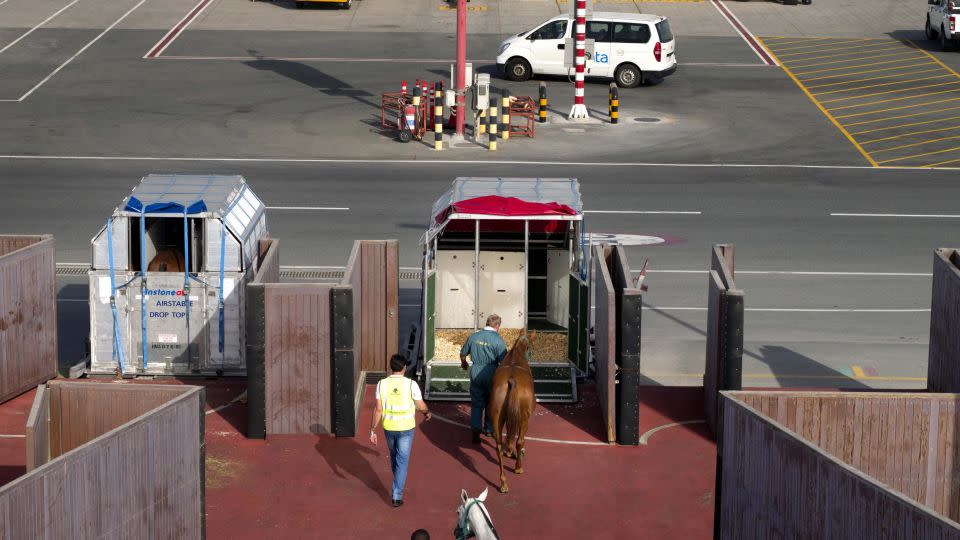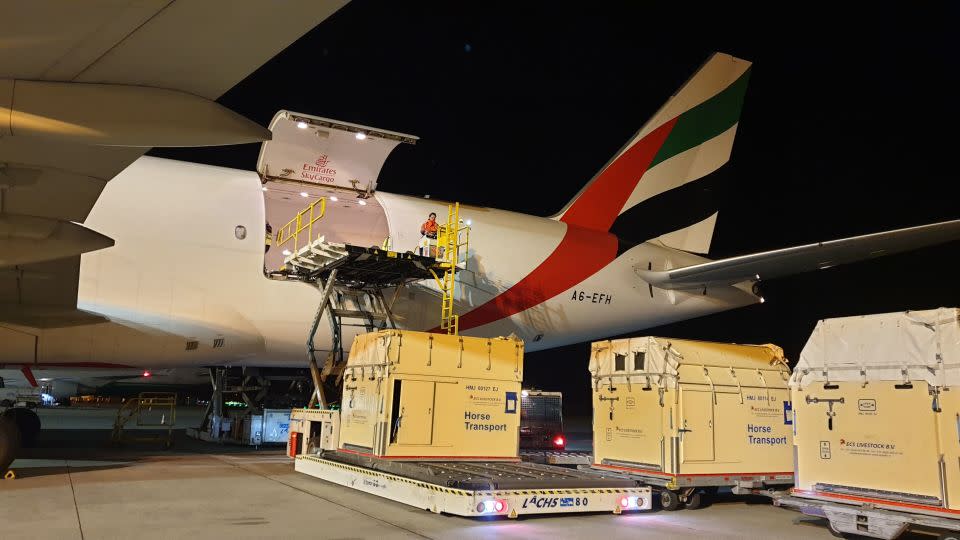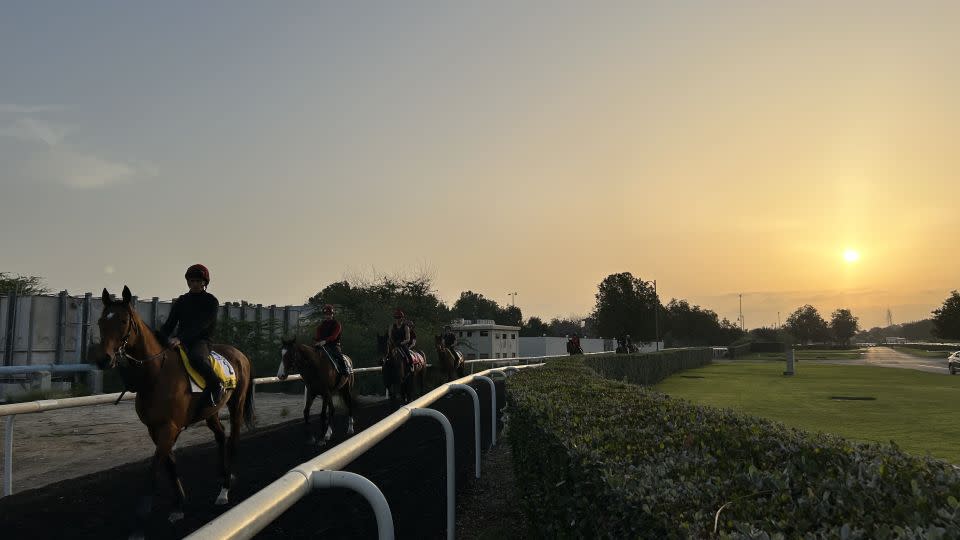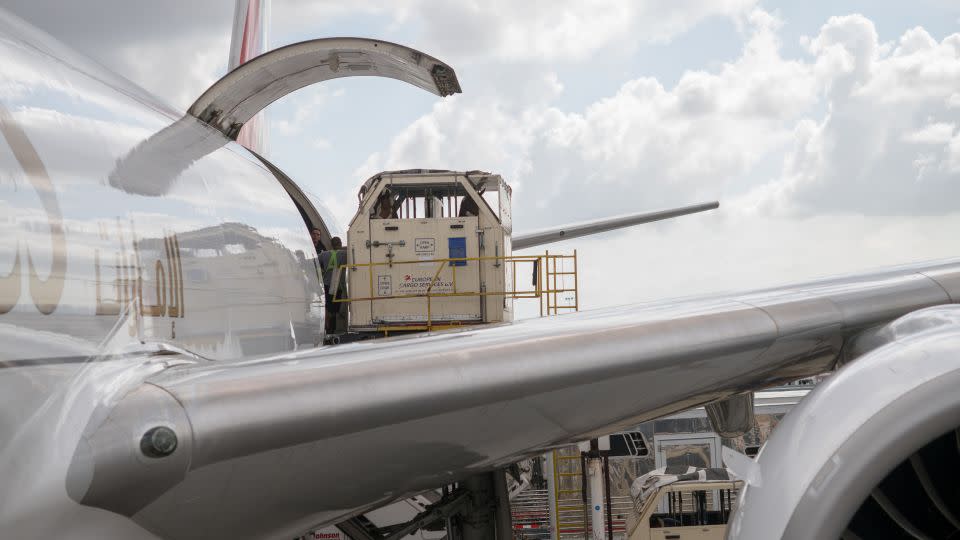How elite horses travel to one of the world’s biggest racing events
On Saturday, 122 athletes awaited their turn to compete at one of the world’s most prestigious tracks. Around two-thirds of them had flown in, from 14 countries across five continents, to attend one of the biggest racing events in their sport.
These runners weren’t wearing sneakers, though — because they’re horses.
The Dubai World Cup boasts $30.5 million in prizes, spread across nine races (including its namesake event, with an enormous $12 million purse), and attracts many of the world’s most elite equestrians.
While the races themselves last a matter of minutes, the transportation of the horses takes months of preparation and hundreds of people.
“This is a huge operation,” says John Nicholls, quarantine manager at Dubai Racing Club. Nicholls and his team are responsible for ensuring the health of the horses from when they touch down in the city until they leave again, and oversee the race club’s quarantine stables at the $1-billion Meydan Racecourse.
“It’s basically five-star all the way,” says Nicholls. “They get plenty of water, plenty of hay, and attention.”

Economy, business, or first
Sheikh Mohammed bin Rashid Al Maktoum, the ruler of Dubai and an avid horse racing fan, has his own Boeing 747 that usually transports all racehorses for the event in and out of the city.
“Unfortunately, the plane is in maintenance at the moment, so the horses are flying on commercial — it’s not a great deal of difference, but it’s much more convenient for us to have our own aircraft,” says Nicholls.
Horses travel in air-conditioned stalls in the cargo bay of a plane, which can fit up to 25 stalls, with up to three horses in each. In the equestrian world, they call this economy, with two to a stall business class, and one to a stall the equivalent of flying first, says Nicholls.
In Emirates planes, the horses ride in tailor-made stalls, with adjustable roofs, ventilation covers to control light and temperature, and non-slip rubber floors — “the equine equivalent to Business Class travel,” regardless of how many are in the stall, says Nadeem Sultan, senior vice president of cargo planning and freighters at Emirates SkyCargo.
But unlike with human passengers, more space doesn’t always make them more comfortable, says Suné Schäffler, general manager at Equitrans, an equestrian logistics service that works with Dubai Racing Club to fly the horses.
“They’re herd animals, so they want to be close to each other, especially the younger the horses. As long as they can see the horse next to them, then they’re fine,” says Schäffler.
Bigger horses might need more room, but that’s not always the case: “Certain horses have different travel behaviors — they might be small, but they’re a little firecracker, so they need bigger spaces,” she says. Others get claustrophobic and will become agitated if they touch the sides of their stall, so are given a roomier ride to prevent them from panicking and hurting themselves.

Professional groomsmen, or horse handlers, travel with the horses throughout the loading process and journey, along with a veterinarian. Take-off and landing are the most difficult times, and when any problems are most likely to occur. Horses often wear protective items, such as socks to support their joints, or headgear to soften bumps, and even earplugs if they are upset by loud noises.
The horses are given water throughout the flight but aren’t fed their typical meals — however, keeping them occupied is essential to a stress-free flight, says Schäffler, so horses are often given hay or grass to chomp on.
In general, though, horses travel “very well,” especially ones that are as used to it as these international athletes, says Schäffler: “The horses are actually very easy.”
It’s the people — and vast quantities of equipment they bring — that cause the biggest strain on transport teams, says Nicholls. He conservatively estimates that at least 5,000 kilograms (11,000 pounds) of equipment traveled with the 82 horses this year, ranging from riding tack to food, and even their own water supply for the duration of their stay.
“People bring all sorts of stuff that they don’t really need,” says Nicholls. He recalls that one person flew with a crate so large that the airport didn’t have a forklift big enough to move it, while another brought an antique metal chest filled with spare riding equipment. All the equipment also has to go through customs, and when things aren’t clearly labeled, it causes huge hold-ups, he says.

Some trainers will even bring their own straw and stable bedding — sometimes to mitigate dust allergies, but often in a bid to manage every detail of the horse’s routine.
“It’s a control thing,” says Nicholls, adding that the sport is rife with superstition: for example, stalls or boxes used by a previous winner are hot property, and horses often wear lucky talismans on their bridles.
Pony passports
For the Dubai World Cup, horses land at Al Maktoum Airport on the city’s outskirts, around a 45-minute drive to Meydan Racecourse, which allows horses to transfer from the ground transport vehicle to the horse stall easily and further mitigate the risk of injury.
A key part of getting the horses on and off the tarmac as quickly as possible is the documentation, like passports, that companies like Equitrans deal with.
“The horses need to meet certain requirements when they travel, in terms of residency, maybe to quarantine before or after arrival, blood tests and vaccinations,” says Schäffler. Horses have unique microchip numbers, which are the main way they are identified, but their passport will also indicate their color, sex, breed and unique markings on a diagram to help security easily identify them.
Equitrans founding partner David Robson estimates that the cost of flying in the 82 horses for the competition is between $2.5-3.5 million.
The vast amount of paperwork that companies like Equitrans go through speeds up the security checks for the horses — and makes the journey relatively simple for the team traveling to the event.

“The transportation is quite easy for the Hong Kong horses to here (Dubai) because the quarantine time is not too long for us,” says Toto Wong, race commentator for the Hong Kong Jockey Club, who traveled to Dubai with the Hong Kong team. Hong Kong’s horses arrived 11 days before the competition, says Wong, which gives them time to settle into their new environment ahead of the race.
Like people, horses can get jet-lagged, although it affects some more than others. It’s one reason that Nicholls recommends that horses arrive two to three weeks before the race, “to get them acclimatized” — although for this event, horses were still arriving five days before the race, and Nicholls has seen horses flown in the day before they compete.
While for many people the Dubai World Cup ended on Saturday evening, people like Nicholls and Schäffler only get busier: horses began flying home as soon as Sunday morning.
“Most of them aren’t fazed by it,” says Nicholls, adding that whether they’re flying economy or not, “they’re looked after first class.”
For more CNN news and newsletters create an account at CNN.com

